|
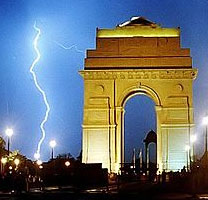 Delhi, locally pronounced as Dilli (Hindi: दिल्ली, Punjabi: ਦਿੱਲੀ, Urdu: دِلّی, Dehli), officially National Capital Territory of Delhi (NCT), is the largest metropolis by area and the second-largest metropolis by population in India. It is the Delhi, locally pronounced as Dilli (Hindi: दिल्ली, Punjabi: ਦਿੱਲੀ, Urdu: دِلّی, Dehli), officially National Capital Territory of Delhi (NCT), is the largest metropolis by area and the second-largest metropolis by population in India. It is the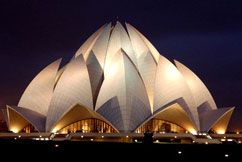 eighth largest metropolis in the world by population with more than 12.25 million inhabitants in the territory. There are nearly 22.2 million residents in the greater National Capital Region urban area (which also includes Noida, Greater Noida, Ghaziabad, Gurgaon and Faridabadalong with other smaller nearby towns).] The name Delhi is often also used to include urban areas near the NCT, as well as to refer to New Deli, the capital of India, which lies within the metropolis. Although technically a federally administered union territory, the political administration of the NCT of Delhi today more closely resembles that of a state of India with its own bicameral legislature, high court and an executive council of ministers headed by a Chief Minister. New Delhi, jointly administered by both the federal Government of India and the local Government of Delhi, is also the capital of the NCT of Delhi. eighth largest metropolis in the world by population with more than 12.25 million inhabitants in the territory. There are nearly 22.2 million residents in the greater National Capital Region urban area (which also includes Noida, Greater Noida, Ghaziabad, Gurgaon and Faridabadalong with other smaller nearby towns).] The name Delhi is often also used to include urban areas near the NCT, as well as to refer to New Deli, the capital of India, which lies within the metropolis. Although technically a federally administered union territory, the political administration of the NCT of Delhi today more closely resembles that of a state of India with its own bicameral legislature, high court and an executive council of ministers headed by a Chief Minister. New Delhi, jointly administered by both the federal Government of India and the local Government of Delhi, is also the capital of the NCT of Delhi.
Located on the banks of the River Yamuna, Delhi has been known to be continuously inhabited 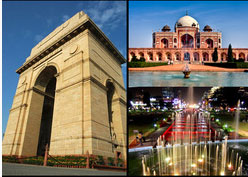 since at least the 6th century BCE, though human habitation is believed to have existed since the second millenium BCE. Delhi is also widely believed to have been the site of Indraprastha, the legendary capital of the Pandavas during the times of the Mahabharata. Delhi re-emerged as a major political, cultural and commercial city along the trade routes between northwest India and the Gangetic plain after the rise of the Delhi sultanates It is the site of many ancient and medieval monuments, archaeological sites and remains. In 1639, Mughal emperor Shahjahan built a new walled city in Delhi which served as the capital of the Mughal Empire from 1649 to 1857. since at least the 6th century BCE, though human habitation is believed to have existed since the second millenium BCE. Delhi is also widely believed to have been the site of Indraprastha, the legendary capital of the Pandavas during the times of the Mahabharata. Delhi re-emerged as a major political, cultural and commercial city along the trade routes between northwest India and the Gangetic plain after the rise of the Delhi sultanates It is the site of many ancient and medieval monuments, archaeological sites and remains. In 1639, Mughal emperor Shahjahan built a new walled city in Delhi which served as the capital of the Mughal Empire from 1649 to 1857.
After the British East India Company had gained control of much of India during the 18th and 19th centuries, Calcutta became the capital both under Company rule and under the British Raj, until George V announced in 1911 that it was to move back to Delhi. A new capital city, New Delhi, was built to the south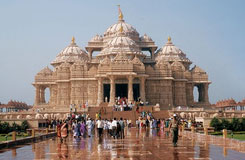 of the old city during the 1920s When India gained independence from British rule in 1947, New Delhi was declared its capital and seat of government. As such, New Delhi houses important offices of the federal government, including the Parliament of India, as well as numerous national museums, monuments, and art galleries. of the old city during the 1920s When India gained independence from British rule in 1947, New Delhi was declared its capital and seat of government. As such, New Delhi houses important offices of the federal government, including the Parliament of India, as well as numerous national museums, monuments, and art galleries.
Owing to the migration of people from across the country, Delhi has grown to be a multicultural, cosmopolitan metropolis. Its rapid development and urbanisation, coupled with the relatively high average income of its population, has transformed Delhi into a major cultural, political, and commercial centre of India
Etymology and idioms
The etymology of "Delhi" is uncertain, but many possibilities exist. The very common view is 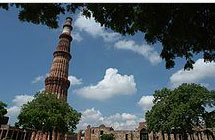 that its eponym is Dhillu or Dilu, a king of the Mauryan dynasty, who built the city in 50 BC and named it after himself.[13][6][14] The Hindi/Prakrit word dhili ("loose") was used by the Tomaras to refer to the city because the Iron Pillar built by Raja Dhava had a weak foundation and was replaced.[14] The coins in circulation in the region under the Tomaras were called dehliwal.[15] Some other historians believe that the name is derived from Dilli, a corruption of dehleez or dehali—Urdu for 'threshold'—and symbolic of city as a gateway to the Gangetic Plain. Another theory suggests that the city's original name was Dhillika.[17] that its eponym is Dhillu or Dilu, a king of the Mauryan dynasty, who built the city in 50 BC and named it after himself.[13][6][14] The Hindi/Prakrit word dhili ("loose") was used by the Tomaras to refer to the city because the Iron Pillar built by Raja Dhava had a weak foundation and was replaced.[14] The coins in circulation in the region under the Tomaras were called dehliwal.[15] Some other historians believe that the name is derived from Dilli, a corruption of dehleez or dehali—Urdu for 'threshold'—and symbolic of city as a gateway to the Gangetic Plain. Another theory suggests that the city's original name was Dhillika.[17]
Delhi is referenced in various idioms of North Indian and Pakistani languages. Examples include -
•Abhi Dilli door hai (or, its Persian version, Hanooz Dilli door ast) literally meaning Delhi is still far away, which is generically said about a task or journey is still far from complete.[18][19]
•Dilli dilwalon ka shehr or Dilli Dilwalon ki meaning Delhi belongs to the large-hearted/daring.[20]
•Aas-paas barse, Dilli pari tarse literally meaning it pours all around, while Delhi lies parched. An allusion to the sometimes semi-arid climate of Delhi, it idiomatically refers to situations of deprivation when there is plenty all
History
• Main articles: History of Delhi and Old De
•At 72.5 m (238 ft), the Qutub Minar is the world's tallest free-standing brick minaret.[2
•Bult in 1560, Humayun's Tomb is the first example of Mughal tomb complexes.[22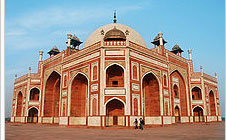
•Red Fort, a UNESCO World Heritage Site, is the location from which the Prime Minister of India addresses the nation on Independence Day
• Human habitation was probably present in and around Delhi during the second millennium BC and before,[5] and continuous inhabitation has been evidenced since at least the 6th century BC.[4] The city is believed to be the site of Indraprastha, legendary capital of the Pandavas in the Indian epic Mahabharata.[6] Settlements grew from the time of the Mauryan Empire (c. 300 BC).[5]
• Remains of seven major cities have been discovered in Delhi. The Tomara dynasty founded the city of Lal Kot in AD 736. The Chauhans conquered Lal Kot in 1180 and renamed it Qila Rai Pithora. The Chauhan king Prithviraj III was defeated in 1192 by the Afghan Muhammad Ghori.[6
• In 1206, Qutb-ud-din Aybak, the first ruler of the Slave Dynasty established the Delhi Sultanate. Qutb-ud-din started the construction the Qutub Minar and Quwwat-al-Islam (might of Islam), the earliest extant mosque in India.[6][23] After the fall of the Slave dynasty, a succession of Turkic and Afghan dynasties, the Khilji dynasty, the Tughluq dynasty, the Sayyid dynasty and the Lodhi dynasty held power in the late medieval period, and built a sequence of forts and townships that are part of the seven cities of Delhi.[24]
•In 1398, Timur Lenk invaded India on the pretext that the Muslim sultans of Delhi were too lenient towards their Hindu subjects. Timur entered Delhi and the city was sacked, destroyed, and left in ruins.[25] Near Delhi, Timur massacred 100,000 captives.[26] Delhi was a major centre of Sufism during the Sultanate period.[27] In 1526, Zahiruddin Babur defeated the last Lodhi sultan in the First Battle of Panipat and founded the Mughal Empire that ruled from Delhi, Agra and Lahore.[6]
• The Mughal Empire ruled northern India for more than three centuries, with a sixteen-year hiatus during the reign of Sher Shah Suri, from 1540 to 1556.[28] During 1553–1556, the Hindu king, Hemu Vikramaditya acceded to the throne of Delhi by defeating forces of Mughal Emperor Akbar at Agra and Delhi. However, the Mughals reestablished their rule after Akbar's army defeated Hemu during the Second Battle of Panipat.[29][30][31] Shah Jahan built the seventh city of Delhi that bears his name (Shahjahanabad), and is more commonly known as the "Old City" or "Old Delhi". The old city served as the capital of the Mughal Empire from 1638. After 1680, the Mughal Empire's influence declined rapidly as the Hindu Marathas rose to prominence.[32]
• A weakened Mughal Empire lost the Battle of Karnal, following which the victorious forces of Nader Shah invaded and looted Delhi, carrying away many treasures, including the Peacock Throne.[33] A treaty signed in 1752 made Marathas the protector of the Mughal throne at Delhi.[34] In 1761, after the Marathas lost the third battle of Panipat, Delhi was raided by Ahmed Shah Abdali. In 1803, the forces of British East India Company overran the Maratha forces near Delhi and ended the Mughal rule over the city.[35]
•After the Indian Rebellion of 1857, Delhi came under direct rule of the British crown and was made a district province of the Punjab.[6] In 1911, the capital of British India was transferred from Calcutta to Delhi, following which a team of British architects led by Edwin Lutyens designed a new political and administrative area, known as New Delhi, to house the government buildings. New Delhi, also known as Lutyens' Delhi, was officially declared as the capital of the Union of India after the country gained independence on 15 August 1947.
•During the partition of India, thousands of Hindu and Sikh refugees from West Punjab and Sindh fled to Delhi, while many Muslim residents of the city migrated to Pakistan. Starting on 31 October 1984, approximately three thousand Sikhs were killed during the four-day long anti-Sikh riots after the Sikh body guards of then-Prime Minister, Indira Gandhi, assassinated her. Migration to Delhi from the rest of India continues, contributing more to the rise of Delhi's population than the birth rate, which is declining.[36]
•The Constitution (Sixty-ninth Amendment) Act, 1991 declared the Union Territory of Delhi to be formally known as National Capital Territory of Delhi.[37] The Act gave Delhi its own legislative assembly, though with limited powers.[37] In December 2001, the Parliament of India building in New Delhi was attacked by armed militants resulting in the death of six security personnel.[38] India suspected the hand of Pakistan-based militant groups in the attacks resulting in a major diplomatic crisis between the two countries.[39] Delhi again witnessed terrorist attacks in October 2005 and September 2008 resulting in the deaths of 62[40] and 30[41] civilians respectively.
•Geography
•Main article: Environment of Delhi
•River Yamuna near Delhi 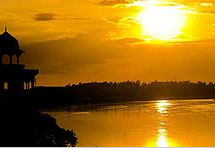
• Lightning strikes near India Gate, New Delhi. Delhi receives much of its rainfall during the monsoon season which lasts from July to Septemb
•The National Capital Territory of Delhi is spread over an area of 1,484 km2 (573 sq mi) , of which 783 km2 (302 sq mi) is designated rural, and 700 km2 (270 sq mi) urban. Delhi has a maximum length of 51.9 km (32 mi) and the maximum width of 48.48 km (30 mi). There are three local bodies (statutory towns) namely, Municipal Corporation of Delhi (area is 1,397.3 km2 or 540 sq mi), New Delhi Municipal Committee (42.7 km2 or 16 sq mi) and Delhi Cantonment Board (43 km2 or 17 sq mi).[42]
• Delhi is an expansive area, in its extremity it spans from Narela in the north to Badarpur in the south. Najafgarh is the furthest point west, and Seemapuri is its eastern extremity. Places like Shahdara and Bhajanpura are its eastern ends and are one of major shopping centres in Delhi. The NCR encompasses towns south and east of the said border, namely Ghaziabad, Noida, Faridabad and Gurgaon.
• Oddly, the main expanse of Delhi does not follow a specific geographical feature. The main city area of Delhi does not end until Saket in the South, whilst the northern limit is Jahangirpuri and the western limit is Janakpuri-Dwarka. The terrain of Delhi shows great variation. It changes from plain agricultural fields in the north to dry, arid hills (an offshoot of the Aravalli Hills of Rajasthan) in the south and west. There used to be large natural lakes in the southern part of the city, but most have now dried up. Most of Delhi, including New Delhi, is situated on the western banks of the river Yamuna which separates the main city from eastern suburbs (commonly known as trans-Yamuna), although there is a good connectivity between the eastern and western sides, with a number of road and railway bridges as well as the Delhi Metro.
•Delhi is located at 28°37′N 77°14′E / 28.61°N 77.23°E / 28.61; 77.23, and lies in northern India. It borders the Indian states of Uttar Pradesh to the east and Haryana on the north, west and south. During British Raj it was adjacent to the province of Punjab and still historically and culturally tied closely to the region of Punjab.[43] Almost entirely within the Gangetic plains, two prominent features of the geography of Delhi are the Yamuna flood plains and the Delhi ridge. The low-lying Yamuna flood plains provide fertile alluvial soil suitable for agriculture but are prone to recurrent floods. Reaching up to a height of 318 m (1,043 ft),[44] the Delhi ridge forms a dominating feature in this region. It originates from the Aravalli Range in the south and encircles the west, northeast and northwest parts of the city. Yamuna, a sacred river in Hinduism, is the only major river flowing through Delhi. Another river called the Hindon River separates Ghaziabad from the eastern part of Delhi. Delhi falls under seismic zone-IV, making it vulnerable to major earthquakes, but earthquakes have not been common in recent history.[45] Delhi has the third highest tree-cover among cities in India.[46]
•Delhi was one of the world's ten most polluted cities in the 1990s, with vehicles producing 70% of the polluting emissions.[47] In 1996 the Centre for Science and Environment started a public interest litigation in the Supreme Court of India that ordered the conversion of Delhi's fleet of buses and taxis to be run on Compressed Natural Gas and banned the use of leaded petrol in 1998. In 2003, Delhi won the United States Department of Energy’s first ‘Clean Cities International Partner of the Year’ award for ‘‘bold efforts to curb air pollution and support alternative fuel initiatives’’.[47]
•Delhi features an atypical version of the humid subtropical climate (Köppen Cwa). Summers are long and extremely hot, from early April to mid-October, with the monsoon season in between. Early March sees a reversal in the direction of wind, from the north-western direction, to the south-western. These bring the hot waves from Rajasthan, carrying sand and are a characteristic of the Delhi summer. These are called loo. The months of March to May see a time of hot prickling heat. Monsoon arrives at the end of June, bringing some respite from the heat, but increasing humidity at the same time. The brief, mild winter starts in late November and peaks in January and is notorious for its heavy fog.[48]
•Extreme temperatures range from −0.6 °C (30.9 °F) to 46.7 °C (116.1 °F).[49] The annual mean temperature is 25 °C (77 °F); monthly mean temperatures range from 13 °C to 32 °C (56 °F to 90 °F).[50] The average annual rainfall is approximately 714 mm (28.1 inches), most of which is during the monsoons in July and August.[6] The average date of the advent of monsoon winds in Delhi is 29 June.[51]
• Civic administration
•See also: Divisions of Delhi, Districts of Delhi, and List of towns in National Capital Territory of Delhi
•As of July 2007, the National Capital Territory of Delhi comprises nine districts, 27 tehsils, 59 census towns, 165 villages and three statutory towns – the Municipal Corporation of Delhi (MCD); the New Delhi Municipal Committee (NDMC); and the Delhi Cantonment Board (DCB).[53]
· Map showing the nine districts of Delh
· The Delhi metropolitan area lies within the National Capital Territory of Delhi (NCT). The NCT has three local municipal corporations: Municipal Corporation of Delhi (MCD), New Delhi Municipal Council (NDMC) and Delhi Cantonment Board. MCD is one of the largest municipal corporations in the world providing civic amenities to an estimated 13.78 million people.[54] The capital of India, New Delhi, falls under the administration of NDMC. The chairperson of the NDMC is appointed by the Government of India in consultation with the Chief Minister of Delhi.[citation needed
· Delhi has four major satellite cities, which lie outside the National Capital Territory of Delhi. These are Gurgaon and Faridabad (in Haryana), and New Okhla Industrial Development Authority (Noida) and Ghaziabad (in Uttar Pradesh). Delhi is divided into nine districts. Each district (division) is headed by a Deputy Commissioner and has three subdivisions. A Subdivision Magistrate heads each subdivision. All Deputy Commissioners report to the Divisional Commissioner. The District Administration of Delhi is the enforcing department for all kinds of State and Central Government policies and exercises supervisory powers over numerous other functionaries of the Government.[citation needed
· The Delhi High Court has jurisdiction over Delhi. Delhi also has lower courts: the Small Causes Court for civil cases; the Magistrate Court and the Sessions Court for criminal cases. The Delhi Police, headed by the Police Commissioner, is one of the largest metropolitan police forces in the world.[55] Delhi is administratively divided into nine police-zones, which are further subdivided into 95 local police stations.[56]
· [edit] Government and politi
· Mai aricle: Government of Delhi 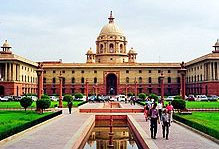
· The North Block, built in 1931 during the British Raj, houses key government offices
· Earlier known as a special union territory, the National Capital Territory of Delhi has its own Legislative Assembly, Lieutenant Governor, council of ministers and Chief Minister. The legislative assembly seats are filled by direct election from territorial constituencies in the NCT. However, the Union Government of India and the Government of National Capital Territory of Delhi jointly administer New Delhi, a city in Delhi, which is the capital and seat of government of both the National Capital Territory of Delhi and of India itself.[citation needed]
· While services like transport and others are taken care of by the Delhi government, services such as the police are
directly under the control of the Central Government.[57] The legislative assembly was re-established in 1993 for the first time since 1956, with direct federal rule in the span. In addition, the Municipal Corporation of Delhi (MCD) handles civic administration for the city as part of the Panchayati Raj act. New Delhi, an urban area in Delhi, is the seat of both the State Government of Delhi and the Government of India. The Parliament of India, the Rashtrapati Bhavan (Presidential Palace),Cabinet Secretariat and the Supreme Court of India are located in New Delhi. There are 70 assembly constituencies and seven Lok Sabha (Indian parliament's lower house) constituencies in Delhi.[58][59]
· Delhi was a traditional stronghold of the Indian National Congress, also known as the Congress Party. In the 1990s, the Bharatiya Janata Party (BJP) under the leadership of Madan Lal Khurana came into power; however in 1998, Congress regained power under Sheila Dikshit, the incumbent Chief Minister. The Congress retained power in the Legislative Assembly in the 2003 and 2008 elections.[citation
Economy
See also: Gurgaon and Noida
Further information: Economy of India and Economic development in India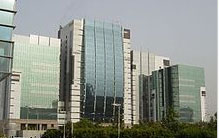
Gurgaon, a satellite city of Delhi, is an important economic hub in the National Capital Region
With an estimated net State Domestic Product (FY 2007) of . 1,182 billion (US$24.5 billion) in nominal terms and . 3,364 billion ($69.8 billion) in PPP terms,[60][61] Delhi is the largest commercial center in northern India.[62] In 2007, Delhi had a per capita income of . 66,728 ($1,450) at current prices, the third highest in India after and Goa as of 2006–07.[63]
The tertiary sector contributes 70.95% of Delhi's gross SDP followed by secondary and primary sectors, with 25.20% and 3.85% contribution, respectively.[61] Delhi's workforce constitutes 32.82% of the population showing an increase of 52.52% between 1991 and 2001.[64] Delhi's unemployment rate decreased from 12.57% in 1999–2000 to 4.63% in 2003.[64] In December 2004, 636,000 people were registered with various employment exchange programmes in Delhi.[64]
In 2001 the total workforce in all government (union and state) and quasi-government sector was 620,000. In comparison, the organised private sector employed 219,000.[64] Key service industries include information technology, telecommunications, hotels, banking, media and tourism.[65] Delhi's manufacturing industry has also grown considerably as many consumer goods industries have established manufacturing units and headquarters in and around Delhi. Delhi's large consumer market, coupled with the easy availability of skilled labour, has attracted foreign investment in Delhi. In 2001, the manufacturing sector employed 1,440,000 workers while the number of industrial units was 129,000.[66]
Construction, power, telecommunications, health and community services, and real estate form integral parts of Delhi's economy. Delhi has India's largest and one of the fastest growing retail industries.[67] As a result, land prices are booming and Delhi is currently ranked the 7th most expensive office hotspot in the world, with prices at $145.16 per square foot.[68] As in the rest of India, the fast growth of retail is expected to affect the traditional unorganized retail trading system.[69]
Utility services
The headquarters of the New Delhi Municipal Corporation (NDMC). On the foreground is Jantar Mantar.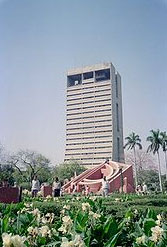
The water supply in Delhi is managed by the Delhi Jal Board (DJB). As of 2006, it supplied 650 MGD (million gallons per day) of water, while the water demand for 2005–06 was estimated to be 963 MGD.[70] The rest of the demand is met by private and public tube wells and hand pumps. At 240 MGD, the Bhakra storage is the largest water source for DJB, followed by the Yamuna and the Ganges.[70] With falling groundwater level and rising population density, Delhi faces severely acute water shortage. Delhi daily produces 8000 tonnes of solid wastes which is dumped at three landfill sites by MCD.[71] The daily domestic waste water production is 470 MGD and industrial waste water is 70 MGD.[72] A large portion of the sewerage flows untreated into the river Yamuna.[72]
The city's per capita electricity consumption is about 1,265 kWh but actual demand is much more.[73] In 1997, Delhi Vidyut Board (DVB) replaced Delhi Electric Supply Undertaking which was managed by the MCD. The DVB itself cannot generate adequate power to meet the city's demand and borrows power from India's Northern Region Grid. As a result, Delhi faces a power shortage resulting in frequent blackouts and brownouts, especially during the summer season when energy demand is at its peak. Several industrial units in Delhi rely on their own electrical generators to meet their electric demand and for back up during Delhi's frequent and disruptive power cuts. A few years ago, the power sector in Delhi was handed over to private companies. The distribution of electricity is carried out by companies run by Tata Power and Reliance Energy. The Delhi Fire Service runs 43 fire stations that attend about 15,000 fire and rescue calls per year.[74]
State-owned Mahanagar Telephone Nigam Limited (MTNL) and private enterprises like Vodafone Essar, Airtel, Idea cellular, Reliance Infocomm, and Tata Indicom provide telephone and cell phone service to the city. In May 2008, Airtel alone had approximately 4 million cellular subscribers in Delhi.[75] Cellular coverage is extensive, and both GSM and CDMA (from Reliance and Tata Indicom) services are available. Affordable broadband penetration is increasing in the city.[76]
Transport
Main article: Transport in Delhi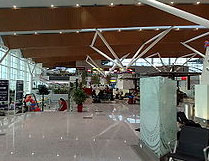
The Indira Gandhi International Airport is one of the busiest airports in South Asia.[77] Shown here is Terminal 1D of the airport.
The Delhi Metro has an average ridership of 900,000 commuters per day and runs at an operational profit.[78]
The DTC operates the world's largest fleet of CNG buses, totaling 9000[47][79]
Public transport in Delhi is provided by buses, auto rickshaws and a metro rail system.
Buses are the most popular means of transport catering to about 60% of the total demand.[80] The state-owned Delhi Transport Corporation (DTC) is a major bus service provider for the city. The DTC operates the world's largest fleet of environment-friendly CNG buses.[81] Delhi BRTS is Bus rapid transit serving the city which runs between Ambedkar Nagar and Delhi Gate.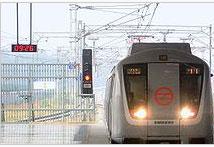
The Delhi Metro, a mass rapid transit system built and operated by Delhi Metro Rail Corporation (DMRC), serves many parts of Delhi as well as the satellite city of Gurgaon in the neighbouring Haryana and Noida in neighbouring Uttar Pradesh. As of October 2010, the metro consists of six operational lines with a total length of 153 km (95 mi) and 130 stations while several other lines are under construction.[82] The Phase-I was built at a cost of US$2.3 billion and the Phase-II will cost an additional US$4.3 billion.[83] Phase-II of the network is under construction and will have a total length of 128 km. It is expected to be completed by 2010.[84] Phase-III and IV will be completed by 2015 and 2020 respectively, creating a network spanning 413.8 km, longer than that of the London Underground.
Auto rickshaws are a popular means of public transportation in Delhi, as they charge a lower fare than taxis. Most run on Compressed Natural Gas (CNG) and are yellow and green in colour. Taxis are not an integral part of Delhi public transport, though they are easily available. Private operators operate most taxis, and most neighborhoods have a taxi stand from which taxis can be ordered or picked up. In addition, air-conditioned radio taxis, which can be ordered by calling a central number, have become increasingly popular, charging a flat rate of . 15 per kilometre.
Delhi is a major junction in the rail map of India and is the headquarters of the N orthern Railway. The five main railway stations are New Delhi Railway Station, Old Delhi, Nizamuddin Railway Station, Anand Vihar Railway Terminal and Sarai Rohilla.[80] Delhi is connected to other cities through many highways and expressways. Delhi currently has three expressways and three are under construction to connect it with its prosperous and commercial suburbs. The Delhi-Gurgaon Expressway connects Delhi with Gurgaon and the international airport. The DND Flyway and Noida-Greater Noida Expressway connect Delhi with two prosperous suburbs of Noida and Greater Noida. orthern Railway. The five main railway stations are New Delhi Railway Station, Old Delhi, Nizamuddin Railway Station, Anand Vihar Railway Terminal and Sarai Rohilla.[80] Delhi is connected to other cities through many highways and expressways. Delhi currently has three expressways and three are under construction to connect it with its prosperous and commercial suburbs. The Delhi-Gurgaon Expressway connects Delhi with Gurgaon and the international airport. The DND Flyway and Noida-Greater Noida Expressway connect Delhi with two prosperous suburbs of Noida and Greater Noida.
Indira Gandhi International Airport (DEL) is situated in the western corner of Delhi and serves as the main gateway for the city's domestic and international civilian air traffic. In 2006–07, the airport recorded a traffic of more than 23 million passengers,[85][86] making it one of the busiest airports in South Asia. A new US$1.93 billion Terminal 3 handles an additional 34 million passengers annually in 2010.[87] Further expansion programs will allow the airport to handle more than 100 million passengers per annum by 2020.
Private vehicles account for 30% of the total demand for transport.[80] At 1922.32 km of road length per 100 km², Delhi has one of the highest road densities in India.[80] Delhi is well connected to other parts of India by five National Highways: NH 1, 2, 8, 10 and 24. Roads in Delhi are maintained by MCD (Municipal Corporation of Delhi), NDMC, Delhi Cantonment Board, Public Works Department (PWD) and Delhi Development Authority.[88]
Delhi's high population growth rate, coupled with high economic growth rate has resulted in an ever increasing demand for transport creating excessive pressure on the city's existent transport infrastructure. As of 2008. Also, the number of vehicles in the metropolitan region, i.e., Delhi NCR is 112 lakhs (11.2 million).[89] In 2008, there were 85 cars in Delhi for every 1,000 of its residents.[90] In order to meet the transport demand in Delhi, the State and Union government started the construction of a mass rapid transit system, including the Delhi Metro.[80] In 1998, the Supreme Court of India ordered all public transport vehicles of Delhi to use compressed natural gas (CNG) as fuel instead of diesel and other hydro-carbons.[91]
Demographics
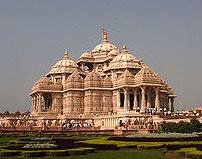
Many ethnic groups and cultures are represented in Delhi, making it a cosmopolitan city. Being the political and economic hub of northern India, the city attracts workers – both blue collar and white collar – from all parts of India, further enhancing its diverse character. A diplomatic hub, home to the embassies of 160 countries, Delhi has a large expatriate population as well.[citation needed
Muslims form 12% of Delhi's population. Shown here is Jama Masjid, the largest mosque in India.
Many ethnic groups and cultures are represented in Delhi, making it a cosmopolitan city. Being the political and economic hub of northern India, the city attracts workers – both blue collar and white collar – from all parts of India, further enhancing its diverse character. A diplomatic hub, home to the embassies of 160 countries, Delhi has a large expatriate population as well.[citation needed]
According to the 2001 Census of India, the population of Delhi that year was 13,782,976.[1] The corresponding population density was 9,294 persons per km², with a sex ratio of 821 women per 1000 men, and a literacy rate of 81.82%. By 2004, the estimated population had increased to 15,279,000. That year, the birth rate, death rate and infant mortality rate (per 1000 population) were 20.03, 5.59 and 13.08, respectively.[93] As of 2007, the National Capital Territory of Delhi had an estimated population of 21.5 million people, making it the second largest metropolitan area in India after Mumbai.[94] According a 1999–2000 estimate, the total number of people living below the poverty line, defined as living on $11 or less per month, in Delhi was 1,149,000 (which was 8.23% of the total population, compared to 27.5% of India as a whole).[95] In 2001, the population of Delhi increased by 285,000 as a result of migration and by an additional 215,000 as a result of natural population growth[93] – this made Delhi one of the fastest growing cities in the world. By 2015, Delhi is expected to be the third-largest agglomeration in the world after Tokyo and Mumbai.[96] Dwarka, Asia's largest planned residential colony, is located within the National Capital Territory of Delhi.[97]
Hinduism is the religion of 82% of Delhi's population. There are also large communities of Muslims (12%), Sikhs (3.9%), Baha'i (0.1%), Jains (1.1%) and Christians (0.9%) in the city.[98] Other minorities include Parsis, Anglo-Indians, Buddhists and Jews.[99]
Hindustani language is the principal spoken language while English is the principal written language of the city. Other languages commonly spoken in the city are dialects of Hindi, Punjabi and Urdu. The linguistic groups from all over India are well represented in the city; among them are Punjabi, Haryanvi, UP, Rajasthani, Bihari, Bengali, Sindhi, Tamil, Garhwali ,Telugu, North-East, Kannada, Malayalam, Marathi and Gujarati.[citation needed]
In 2005, Delhi accounted for the highest percentage (16.2%) of the crimes reported in the 35 cities in India with populations of one million or more.[100] The city also has the highest rate of crime against women (27.6 compared to national average rate of 14.1 per 100,000) and against children (6.5 compared to national average of 1.4 per 100,000) in the country.[101]
[edit] Culture
See also: Culture of India
Traditional pottery on display in Dilli Haat
Rice and Kadhai Chicken from Delhi
Delhi's culture has been influenced by its lengthy history and historic association as the capital of India. This is exemplified by the many monuments of significance found in the city; the Archaeological Survey of India recognises 1200 heritage buildings[102] and 175 monuments in Delhi as national heritage sites.[103] The Old City is the site where the Mughals and the Turkic rulers constructed several architectural marvels like the Jama Masjid (India's largest mosque)[104] and Red Fort. Three World Heritage Sites—the Red Fort, Qutab Minar and Humayun's Tomb—are located in Delhi.[105] Other monuments include the India Gate, the Jantar Mantar (an 18th-century astronomical observatory) and the Purana Qila (a 16th century fortress). The Laxminarayan Temple, Akshardham and the Bahá'í Lotus Temple are examples of modern architecture. Raj Ghat and associated memorials houses memorials of Mahatma Gandhi and other notable personalities. New Delhi houses several government buildings and official residences reminiscent of the British colonial architecture. Important structures include the Rashtrapati Bhavan, the Secretariat, Rajpath, the Parliament of India and Vijay Chowk. Safdarjung's Tomb is an example of the Mughal gardens style.[citation needed]
Delhi's association and geographic proximity to the capital, New Delhi, has amplified the importance of national events and holidays. National events like Republic Day, Independence Day and Gandhi Jayanti (Gandhi's birthday) are celebrated with great enthusiasm in Delhi. On India's Independence Day (15 August) the Prime Minister of India addresses the nation from the Red Fort. Most Delhiites celebrate the day by flying kites, which are considered a symbol of freedom.[106] The Republic Day Parade is a large cultural and military parade showcasing India's cultural diversity and military might.[107][108] Over the centuries Delhi is known for its composite culture, and a festival that symbolizes it truly is the Phool Walon Ki Sair, which takes place each year in September, and where flowers and fans embroidered with flowers, pankha are offered to the shrine of 13th century Sufi saint, Khwaja Bakhtiyar Kaki, along with the Yogmaya Temple also situated in Mehrauli.[109]
Religious festivals include Diwali (the festival of lights), Mahavir Jayanti, Guru Nanak's Birthday, Durga Puja, Holi, Lohri, Chhath, Krishna Janmastami, Maha Shivaratri, Eid ul-Fitr, Moharram and Buddha Jayanti.[108] The Qutub Festival is a cultural event during which performances of musicians and dancers from all over India are showcased at night, with the Qutub Minar as the chosen backdrop of the event.[110] Other events such as Kite Flying Festival, International Mango Festival and Vasant Panchami (the Spring Festival) are held every year in Delhi. The Auto Expo, Asia's largest auto show,[111] is held in Delhi biennially. The World Book Fair, held biannually at the Pragati Maidan, is the second largest exhibition of books in the world with as many as 23 nations participating in the event.[112] Delhi is often regarded as the "Book Capital" of India because of high readership.[113]
The Auto Expo is held annually at Pragati Maidan and showcases the technological prowess of the Indian automobile industry
Punjabi and Mughlai delicacies like kababs and biryanis are popular in Delhi. The street food there is known to be delicious and includes chaat, golgappe and aloo tikki. [114][115] Due to Delhi's large cosmopolitan and migrant population, cuisines from every part of India, including Gujarati Rajasthani, Maharashtrian, Bengali, Hyderabadi cuisines, and South Indian food items like idli, sambar and dosa are widely available. Local delicacies include Chaat, Golgappe, Aloo-Tikki and Dahi-Papri. There are several food outlets in Delhi serving international cuisine, including Italian, Japanese, Continental, Middle-Eastern, Thai and Chinese. Within the last decade western fast food has become more popular as well.
Historically, Delhi has always remained an important trading centre in northern India. Old Delhi still contains legacies of its rich Mughal past, which can be found among the old city's tangle of snaking lanes and teeming bazaars.[116] The dingy markets of the Old City have an eclectic product range, from oil-swamped mango, lime and eggplant pickles, candy-colored herbal potions to silver jewelry, bridal attire, uncut material and linen, spices, sweets.[116] Some of old regal havelis (palatial residences) are still there in the Old City.[117] Chandni Chowk, a three-century-old shopping area, is one of the most popular shopping areas in Delhi for jewellery and Zari saris.[118] Notable among Delhi's arts and crafts are the Zardozi (an embroidery done with gold thread) and Meenakari (the art of enameling). Dilli Haat, Hauz Khas, Pragati Maidan offer a variety of Indian handicrafts and handlooms. Over time Delhi has absorbed a multitude of humanity from across the country and has morphed into an amorphous pool of cultural styles.[12][119]
[edit] Education
See also: Educational Institutions in Delhi
Consistently ranked as India's top medical college,[120] All India Institute of Medical Sciences is a global leader in medical research and treatment[121]
Schools and higher educational institutions in Delhi are administered either by the Directorate of Education, the NCT government, or private organizations. In 2004–05, there were 2,515 primary, 635 middle, 504 secondary and 1,208 senior secondary schools in Delhi. That year, the higher education institutions in the city included 165 colleges, among them five medical colleges and eight engineering colleges,[122] six universities (Delhi University, Jawaharlal Nehru University, Jamia Millia Islamia, Guru Gobind Singh Indraprastha University (GGSIPU), National Law University(Official Website), Indira Gandhi National Open University (IGNOU) and Jamia Hamdard), and nine deemed universities.[122] Guru Gobind Singh Indraprastha University and National Law University are the only state universities; IGNOU is for open/distance learning; the rest are all central universities. Delhi boasts of being home to 3 of top 10 engineering colleges in India – IIT Delhi, NSIT (Formerly DIT) and DTU (Formerly DCE).
Indian Institute of Technology, Delhi is ranked as Asia's fourth-best institute in science and technology in year 1999.[123]
Private schools in Delhi—which employ either English or Hindi as the language of instruction—are affiliated to one of two administering bodies: the Council for the Indian School Certificate Examinations (CISCE), the Central Board for Secondary Education (CBSE) and the National Institute of Open Schooling (NIOS). In 2004–05, approximately 15.29 lakh (1.529 million) students were enrolled in primary schools, 8.22 lakh (0.822 million) in middle schools and 6.69 lakh (0.669 million) in secondary schools across Delhi.[122] Female students represented 49% of the total enrollment. The same year, the Delhi government spent between 1.58% and 1.95% of its gross state domestic product on education.[122]
After completing the ten-year secondary phase of their education under the 10+2+3/4 plan, students typically spend the next two years either in junior colleges or in schools with senior secondary facilities, during which their studies become more focused. They select a stream of study—liberal arts, commerce, science, or, less commonly, vocational. Upon completion, those who choose to continue, either study for a three-year undergraduate degree at a college, or a professional degree in law, engineering, or medicine. Notable higher education or research institutes in Delhi include All India Institute of Medical Sciences, Dr.Ram Manohar Lohia Hospital & PGIMER, Jawaharlal Nehru University, Indian Statistical Institute, Indian Institute of Technology Delhi, Indian Institute of Foreign Trade, Delhi Technological University, National Law University, Delhi, Netaji Subhas Institute of Technology, Indian Law Institute, Delhi School of Economics, Jamia Millia Islamia. As of 2008, about 16% of all Delhi residents possessed at least a college graduate degree.[124]
[edit] Media
Pitampura TV Tower broadcasts programming to Delhi
As the capital of India, New Delhi is the focus of political reportage, including regular television broadcasts of Parliament sessions. Many country-wide media agencies, among them the state-owned Press Trust of India , Media Trust Of India and Doordarshan, are based in the city. Television programming in the city includes two free terrestrial television channels offered by Doordarshan, and several Hindi, English and regional-languages cable channels offered by multi system operators. Satellite television, in contrast, has yet to gain large-scale subscribership in the city.[125]
Print journalism remains a popular news medium in Delhi. During 2004–05, 1029 newspapers in thirteen languages were published from the city. Of these, 492 were Hindi language newspapers, including Navbharat Times, Hindustan Dainik, Punjab Kesari, Pavitra Bharat, Dainik Jagran, Dainik Bhaskar and Dainik Desbandhu. Amongst the English language newspapers, The Hindustan Times, with over a million copies in circulation, was the single largest daily. Other major English newspapers include Times of India, The Hindu, Indian Express, Business Standard, The Pioneer and Asian Age. Regional dailies include Malayala Manorama and Dinakaran. Radio is a less popular mass medium in Delhi, although FM radio has been gaining ground[126] since the inauguration of several new FM channels in 2006.[127] A number of state-owned and private radio stations broadcast from Delhi, including All India Radio (AIR), one of the world's largest radio service providers, which offers six radio channels in ten languages. Other city-based radio stations include "Aaj Tak", "Radio City(91.1 MHz)", "Big FM(92.7 MHz)", "Red FM(93.5MHz)", "Radio One(94.3 MHz)", "Hit FM(95 MHz)", "Apna Radio", "Radio Mirchi(98.3 MHz)", "FM Rainbow(102.4 MHz)", "Fever FM(104 MHz)", "Meow FM(104.8 MHz)", "FM Gold(106.4 MHz)".
Various news and general interest magazines are also published from Delhi like India Today, Outlook, COVERT and many more.
[edit] Sports
The 2010 Commonwealth Games was the largest sports event held in India. Shown here is the Opening Ceremony at the Jawaharlal Nehru Stadium, the third largest stadium in India.
Cricket and soccer are the most popular sports in Delhi.[128] There are several cricket grounds (or maidans) located across the city. The Feroz Shah Kotla stadium is one of the oldest cricket grounds in India and is a venue for international cricket matches. The Delhi cricket team represents the city in the Ranji Trophy, a domestic first-class cricket championship.[129] The city is also home to the IPL team Delhi Daredevils, and ICL team Delhi Giants (earlier named Delhi Jets).
Football is a very popular sport in the city and is home to the newly formed AIFF-u19 club which will take part in the 2011 format of the I League. The only football stadium in Delhi is the Ambedkar Stadium which holds 20000 people though in the past few years due to tremendous rise in popularity of the sport has held up to 50000 people in the past years.Delhi even witnessed India winning back to back trophies in football in the form of the 2007 Nehru Cup defeating Syria 1–0 AFC Challenge Cup 2008 defeating favourites Tajikistan 4–1 by a stellar performance by local Star Sunil Chhetri and the 2009 Nehru Cup.
Rugby has become an increasingly popular sport among youngsters and the city is home to the Delhi Lions and Delhi Hurricanes. The city successfully played host to Asian5Nations Rugby Tournament in 2010. The Only Stadium in the city for this particular sport is in the Delhi University North Campus. Boxing and shooting figure among increasingly popular sports in the suburb of Gurgaon.
Formula 1 has now got a circuit in India in Greater Noida, a suburb of Delhi in the twin cities area of (Noida-Greater Noida), which is all set to host the Indian Grand Prix in October 2011 with the Jaypee Group constructing the circuit. It is set to be among the top 5 fastest circuits in the world. The team, Force India F1, was formed in October 2007 when a consortium led by Indian businessman Vijay Mallya and Michiel Mol bought the Spyker F1 team for € 88 million. Force India F1 represents increased Indian participation within Formula One.
Golf is also a very popular sport in the capital city and the National Capital Region, which is home to the highest number of golf courses in India. Other sports such as field hockey, basketball, tennis, squash, badminton, swimming, kart racing, weightlifting, table tennis, cycling, roller skating and cue sports, such as snooker, billiards and diving are also popular.[citation needed]
Jawaharlal Nehru Stadium and the Indira Gandhi Indoor Stadium are other stadiums in Delhi. In the past, Delhi has hosted several domestic and international sporting events, such as the First and the Ninth Asian Games.[130] Delhi hosted the 2010 Commonwealth Games, the largest multi-sport event ever held in India. Delhi lost bidding for the 2014 Asian Games,[131] and considered making a bid for the 2020 Summer Olympics.[132] However, sports minister Manohar Singh Gill later stated that funding infrastructure would come before a 2020 bid.[133]
|